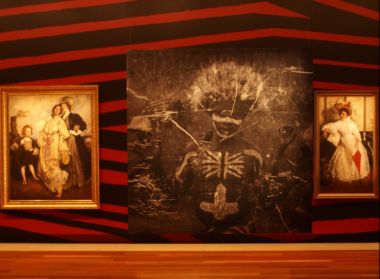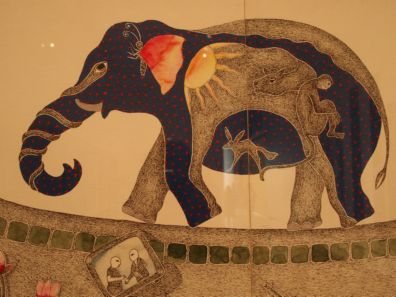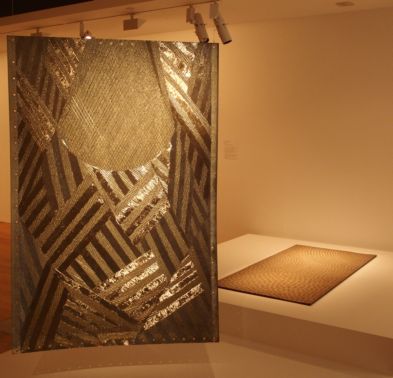THE VERNACULAR AT THE ASIA PACIFIC TRIENNIAL

Brook Andrew's Wiradjuri gallery with photograph of patriotic 'native' and associated pith helmet!
Posted by Jeremy Eccles | 25.11.15
Gallery: Queensland Art Gallery | Gallery of Modern Art (QAGOMA)
Dates:
20.11.15
: 10.04.16
You can spend three years planning for a massive event like the 8th Asia Pacific Triennial (APT) at QAGoMA in Brisbane, and then something small and unpredictable but remarkable happens quite outside all your planning.
So, on the Sunday of the opening weekend, a Gond artist from India, Venkat Ramen Singh Shyam, talking about the revival of the Gond vernacular traditions in central India in the late 20th Century, surprisingly paid tribute to Australian Aboriginal artist, Djambawa Marawili. He'd travelled to India in the 90s, met up with Venkat's pioneering uncle, Jangarh Singh Shyam, even creating an artwork with him in which the importance of water and its relationship to various totemic animals from either side of the Indian Ocean was put down collaboratively on canvas, a coming-together of tribal cultures. But was it “tribal art”, as it was delimited in India?
Marawili said “yes”, of course it's tribal art. But it's also contemporary art, for we are living in the present and reflecting the world today as well as the mythology of our pasts. This gave Jangarh the courage to take his art to the world – and inspire his nephew, who explained in Brisbane, “Every new thought I have is contemporary”.
Then, enter Djon Mundine. The senior Indigenous curator in Australia had, it turned out accompanied Marawili to India and was able to fill in the gaps for Venkat about this seminal moment in contemporary Indian art history – the “liberation” of Gond art, as Marawili's art centre director, Will Stubbs, put it in amazement. Mundine was hardly part of the APT, but was there in an interesting add-on organised by the Arts Councils of Australia, New Zealand and Canada, bringing together Indigenous curators from the three Commonwealth countries. That, it's hoped, will lead to annual meetings accompanied by curated exhibitions of all three countries' artworks and a magazine to record their deliberations.
What do they have in common? I suspect the struggle to be considered 'contemporary' is harder in Australia than the other two. But then the 'Aboriginal' art I've seen from NZ and Canada is mainly of the Western art-trained variety, lacking the visceral authenticity of Desert, Kimberley or Arnhemland art that is made in Australia by artists trained only by thousands of years of pre-literate mnemonics – learning through visual imagery as the West does not.
Only Gunybi Ganambarr and Yakultji Napangati represented this tradition in the APY – odd given the priority given to the vernacular from other countries in the region such as Mongolia, Nepal, Myanmar, Cambodia and, above all, India. Yakultji had not attempted to rise to the challenge of this massive international opportunity, simply supplying two of her classic canvases. But Gunybi (pronounced, I discovered, Guinbee) had taken his adventurism to new extremes with lustrous water-tank engravings, galvanised iron cut with an angle grinder and the addition of powdered ochre 3D designs to the rubber conveyor belts that miners had discarded on his Country over the years, having used them to remove that Country.
Segar Passi from the Torres Strait may be self-taught, but the Christian influence on his island of Mer must have extended into his art, for the largest canvas yet produced by this 73 year old looks unexceptionally Western, while containing much geological and meteorological information and lore. Danie Mellor, however, may identify with the rainforests just south of the Cape, but chooses to make his art with the intellect of an academic rather than the visual instincts of a Mamu/Ngadjonji man. Yves Klein blue, Einstein's discovery of a curved world and Anish Kapoor's voids all creep into his suite of rainforest photos presented on shiny aluminium panels to capture something of the watery tropical world he's responding to.
But in a sense, he's closer to the vernacular works coming from Asia than his fellow Blak artists in the APT – Christian Thompson, Brook Andrew and Richard Bell. For his work is deeply rooted in his ancestry, not just availing himself of it conceptually. So Thompson sings in the Bidjara language most mellifluously – but, as it's all about himself as an individual, quite lacks any sense of traditional ceremony. And Andrew coats three galleries' walls in bold Wiradjuri dendroglyph diagonals before putting back the colonial art that normally hangs there, then adds some very loosely related, grainy photos from the same past. It makes for a collision of cultures in his mind. The photo of an Indian postal worker, for instance, may have had totally unintended links with the delightful Khaligat painting by Kalam Patua showing a heroic postman battling a tiger to get the mail through in India, but failed to make much sense otherwise!
Indeed, round the corner and outside the APT, a striking photo by New Zealander Lisa Reihana called 'The Dandy' stood proud amongst grand European portraits by Romney, Van Dyke and Reynolds. By putting an elegantly tattooed Maori into a 19th Century European outfit and showing just how magnificently her people would have matched their 'masters' if they'd chosen to, she made her case for the retrospective rezoning of Indigenous culture rather better than Andrew.
Provocateur Bell was part of the hugely expanded Kids' APT program, cheekily engaging children on film about their thoughts on fame and fortune.
The performative and the body were a strong part of this APT – encouraged it seems by new QAGoMA Director, Chris Saines But he probably didn't make the links that Will Stubbs from Buku Larrnggay Arts Centre did between Yolngu culture and the Bible. For, just as the Old Testament preceded literacy and would have been the responsibility of the elders to memorise and pass on – inevitably using song to assist them – so Yolngu and other Aboriginal story-telling invariably comes with musical accompaniment. So Gunybi Ganambarr's silent, static works have a musical background that in some ways was more present than the pan-Melanesian Yumi Danis group that had workshopped dances in advance of the APT to lead people into their cultural cave at the top of the GoMA building. Somehow the resulting hip-hop didn't seem to fit the bill.
But the seated Anasheed performance from Western Sydney – an Islamic Sufi male chorus chanting deeply from the Koran and other poetic sources - moved mystically. With lowered eyes and hands only occasionally raised at particularly ecstatic moments, the half-hour performance's dynamic lay entirely in its effect upon our spiritual beings. And, given events in Paris the previous weekend, it was powerful in denying that Islam can mean only fanaticism. For, according to artist George Gittoes' recent film, 'Snow Monkey', the Taliban delight in destroying Sufi shrines in Afghanistan.
From the inside, Nur Shkembri, on an all-Aussie Islamic panel of speakers, explained how, pre-9/11, being Muslim was a private matter with hints of exoticism for the rest of the world. After that event, “we became a threat”, and Aussie artist Abdul Abdullah's series of 'monkey- mask' wedding photos in the exhibition are “calling out the audience's prejudices”.
Intriguing that Australia had as many Islamic artists on show at the APT as Indonesia, Malaysia, the Kyrgyz Republic, Pakistan, etc.
With the once dominant China largely absent, the political baton was taken and run with by the likes of Taloi Havini from Bougainville, Hit Man Gurung from Nepal, Baatzorig Bat Jargal from Mongolia and both Leang Seckon and Khvay Samnang from Cambodia. And I never even found the Georgians!
It's that sort of event – with at least 83 artists from 32 countries, an impossible amount to see, different viewing priorities each time you go, and quite a few dull patches. But, lucky Queenslanders, the APT8 is on until April. Whatever you do, don't miss the panoply of Indians; for, despite the ill-considered thought of Malaysian artist, Yee I-Lann that it's impossible to erase the ethnographic aspect of Indigenous art, they proved to my satisfaction that the retention of their tribal roots and the presence of their gods in their art, they're quite capable of dealing with such contemporary matters as AIDS, rape and the degradation of women, the traumas of the Asian tsunami and environmental pollution.
As Hsieh Fu Hua, Chairman of the new National Gallery Singapore, which opened the same weekend as the APT, resoundingly declared, “Artists are often seen as being unconventional, separate from the mainstream. Through our exhibitions, visitors will realise that in fact, artists are integral to society and that art is not created in a vacuum”.
URL: www.qagoma.qld.gov.au/apt8
Share this:
»  del.icio.us
»
del.icio.us
»  Digg it
»
Digg it
»  reddit
»
reddit
»  Google
»
Google
»  StumbleUpon
»
StumbleUpon
»  Technorati
»
Technorati
»  Facebook
Facebook
Contact Details
Gallery: Queensland Art Gallery | Gallery of Modern Art (QAGOMA)
Email: gallery@qagoma.qld.gov.au
Telephone: +61 7 3840 7303
Address: Stanley Place South Bank Brisbane 4100 QLD
Gallery: Queensland Art Gallery | Gallery of Modern Art (QAGOMA)
Email: gallery@qagoma.qld.gov.au
Telephone: +61 7 3840 7303
Address: Stanley Place South Bank Brisbane 4100 QLD

Gorgeous Gond elephant by Venkat Ramen Singh Shyam

The remains of a Yirrkala water-tank and a mining conveyor belt transformed by Gunybi Ganambarr into Yolngu art
Where is the exhibition?
Further Research
Gallery: Queensland Art Gallery | Gallery of Modern Art (QAGOMA)
Artists: Brook Andrew | Christian Thompson | Danie Mellor | Djambawa Marawili | Gunybi Ganambarr | Richard Bell | Segar Passi | Yakultji Napangati
News Tags: APT8 | Asia Pacific Triennial | Chris Saines | Christian Thompson | Danie Mellor | Djambawa Marawili | Djon Mundine | Gond art | Gunybi Ganambarr | Jeremy Eccles | QAGoMA | Queensland Art Gallery | Will Stubbs | Yakultji Napangati
News Categories: Asia | Australia | Blog | Conference | Event | Exhibition | Festival | News
Exhibition Archive
- 10.10.17 | TARNANTHI 2017
- 11.08.17 | Natsiaas 2017
- 20.07.17 | APY ART DOMINATES THE WYNNE
- 17.07.17 | Anangu Artist Wins $100,000 Prize
- 14.07.17 | The End of AAMU
- 11.07.17 | ART ACROSS THE COUNTRY
- 11.07.17 | TARNANTHI IN OCTOBER
- 05.07.17 | TJUNGUṈUTJA - from having come together
- 13.06.17 | Ghost-Nets Straddle the World
- 07.06.17 | Grayson Perry Going Indigenous?
- 05.06.17 | Barks Bigger than Ben Hur
- 27.05.17 | NGA QUINQUENNIAL 2017
- 21.05.17 | Blak Douglas Finds Home at the NGA
- 21.05.17 | BRIAN ROBINSON WINS HAZELHURST WOP
- 18.05.17 | PARRTJIMA 2.0
Advertising

